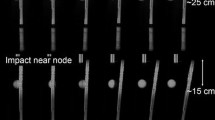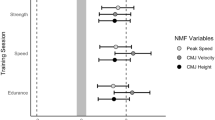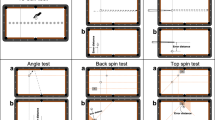Abstract
Eighteen elite male tennis players were tested to determine their ability to identify string tension differences between rackets strung from 210 N (47 lb) to 285 N (64 lb). Each player impacted four tennis balls projected from a ball machine before changing rackets and repeating the test. Eleven participants (61%) could not correctly detect a 75 N (17 lb) difference between rackets. Only two participants (11%) could correctly detect a 25 N (6 lb) difference. To establish whether varying string tensions affected ball rebound dynamics, the ball’s rebound speed and landing position were analysed. The mean rebound ball speed was 117 km h−1, with only the trials from the 210 N racket producing significantly lower (P < 0.05) rebound speeds than the 235 N and 260 N rackets. This is contrary to previous laboratory-based tests where higher rebound speeds are typically associated with low-string tensions. The anomaly may be attributable to lower swing speeds from participants as they were not familiar with such a low string tension. Ball placement did not appear related to string tension, with the exception of more long errors for the 235 N racket and fewer long errors for the 285 N racket. It was concluded that elite male tennis players display limited ability to detect changes in string tension, impact the ball approximately 6% faster than advanced recreational tennis players during a typical rallying stroke, and that ball placement is predominantly unrelated to string tension for elite performers.


Similar content being viewed by others
References
Bower R, Cross R (2003) Player sensitivity to changes in string tension in a tennis racket. J Sci Med Sport 6(1):120–131
Bower R, Cross R (2005) String tension effects on tennis ball rebound speed and accuracy during playing conditions. J Sports Sci 23(7):765–771
Bower R, Sinclair P (1999) Tennis racquet stiffness and string tension effects on rebound velocity and angle for an oblique impact. J Hum Mov Stud 37(6):271–286
Brody H (1979) Physics of the tennis racquet. A J Phys 47(6):482–487
Cross R, Bower R (2001) Measurements of string tension in a tennis racket. Sports Eng 4:165–175
Elliott B (1982) The influence of tennis racquet flexibility and string tension on rebound velocity following a dynamic impact. Res Q Exerc Sport 53(4):277–281
Elliott B, Marsh A, Overheu P (1987) The mechanics of the Lendl and conventional tennis forehands: a coach’s perspective. Sports Coach 11(2):4–9
Elliott B, Marsh A, Overheu P (1989) The topspin backhand drive in tennis: a biomechanical analysis. J Hum Mov Stud 16(1):1–16
Haake S, Carre M, Goodwill S (2003) The dynamic impact characteristics of tennis balls will tennis rackets. J Sports Sci 21:839–850
Hatze H (1993) The relationship between the coefficient of restitution and energy losses in tennis rackets. J Appl Biomech 9:124–142
Groppel J, Shin I, Thomas J, Welk G (1987) The effects of string type and tension on impact in midsized and oversized tennis racquets. Int J Sports Biomech 3:40–46
Author information
Authors and Affiliations
Corresponding author
Rights and permissions
About this article
Cite this article
Bower, R., Cross, R. Elite tennis player sensitivity to changes in string tension and the effect on resulting ball dynamics. Sports Eng 11, 31–36 (2008). https://doi.org/10.1007/s12283-008-0006-z
Published:
Issue Date:
DOI: https://doi.org/10.1007/s12283-008-0006-z




